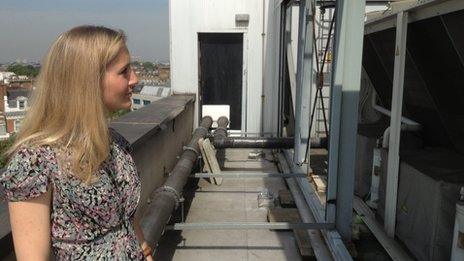Chill out, save energy, no sweat
- Published

There is a huge spike in demand at moments like Andy Murray’s Wimbledon victory
A glance around the lobby of the Marriott Hotel in Kensington reveals no sign that the unsuspecting guests are part of a remote-controlled experiment.
It is roasting hot outside, and they’re sipping cool drinks to escape the UK’s barbecue summer.
But any moment now, the power to the hotel’s air conditioning chillers is about to be turned off.
These happy travellers are guinea pigs in a trial of demand reduction.
We count down the seconds to the appointed moment and an iPad brandished by the controller of the experiment displays an abrupt drop in the hotel’s power consumption.
The chillers have been turned off by a signal from a computer in an office miles away.
Do the punters notice? They do not. Are they wallowing in a pool of perspiration when I return later? They are not. Has any customer complained about the temperature whilst this six-week experiment in the heat wave has been underway? No.
Has anyone even noticed? Apparently not.
This is a perfect result for the Marriott, which is involved in trials of a system designed to ensure that the UK’s lights stay on at times of peak electricity demand.
It has signed up with Kiwi Power, one of a number of firms trying to run demand management on a local scale. If demand and supply can be balanced within the area serviced by one sub-station there are big savings in installing new cables.
Money and hassle
There is a huge spike in demand at moments like Andy Murray’s Wimbledon victory when those not already quaffing champagne have slipped out to put on the kettle.
This sort of peak has typically been met by paying electricity firms to have extra capacity on stand-by.
In the US, a land beset by energy black-outs, some bright spark realised it might be cheaper to pay firms to turn off their power than to build new capacity and rip up roads to get it to people’s homes.
For years, the UK Treasury resisted the idea because it feared that firms would be deterred from improving energy efficiency until they were paid for it.
But the Liberal Democrat Energy Secretary Ed Davey has prevailed. He says the scheme won’t be perfect, but predicts that it will save money and hassle.
It’s especially relevant since the regulator Ofgem warned that the UK’s risk of blackouts would be higher than realised, external by 2015.

Switching off the chillers (seen here on the roof of the Marriott Hotel) at key moments makes a small amount of money
The Marriott is open about its involvement in the scheme. The firm says it has worked hard to reduce energy demand overall because it makes business sense.
On top of routine efficiencies it has agreed for an outside operator to switch off its chillers at key moments because it makes a small amount of money and it is good PR.
The key is to save energy in a way that the partners don’t notice. In the Marriott’s case, Kiwi has attached a small switching unit to the chillers up on the roof. When demand is about to peak, Kiwi send Marriott a message asking if it is willing to suffer a power drop. If the hotel agrees the chillers are switched off remotely.
This sounds more drastic than it is. First, buildings store heat and coolness in their bricks and mortar and it takes a while for them to change state. Second, the "aircon" system here is based on a grid of chilled water pipes, with fans blowing air across the pipes to cool the rooms.
At the start of the one-hour demand reduction, the power to the chillers goes off, but the fans stay on.
Every little helps
Over an hour, the temperature of the pipes rises from a very cool 4C to a pretty cool 6C. Small wonder no one can tell. If the experiment works Marriott may ratchet up the switch-off time to see when people start to notice.
The amount of power saved by this hotel's one-hour experiment is relatively trivial - 30-40 kilowatts, that's enough to boil hundreds of kettles in the hour the power to the chillers is off. But doing this on a daily basis would gain Marriott a subsidy of around £5,000 a quarter, and multiplied across the hotel chain in the UK it could land £700,000 a year. It is money for nothing.
The upside from the consumers’ viewpoint is that if enough firms within the sub-station area can be persuaded to turn their chillers down when people want to put the oven on, it could save investment in new energy systems.
National Grid has a long-standing scheme to incentivise big users to switch to their own stand-by generators at times of peak demand, but the government is currently consulting on including demand reduction in its proposed “capacity mechanism” for ensuring that the lights stay on.
Firms will bid for contracts to keep power flowing at times of need – and the demand reducers expect that their costs will be cheapest.
I put it to Mr Davey that bill-payers might feel cheated at the prospect of paying firms to reduce demand.
He replied: “It’s better value for money. Saving energy is cheaper than creating power – it’s also better for the environment. We are trying to encourage supply as well, but you have to take action on both sides.
“There is a danger that we could be paying firms to do things they would have done anyway but we have to make sure that doesn’t happen. Surely if we can incentivise saving energy it will be cheaper than building power station after power station.”
He could, of course, attempt to persuade the public to use much less energy. But experience suggest that would certainly raise the temperature of the debate.
Follow Roger on Twitter @rharrabin